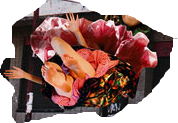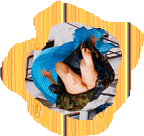Remix




Remix | In 15th century Italy the showing off of wealth involved using too much velvet cloth for clothes, which lead to vast portions being destined for the scrap heap. “In reality of course, everything was saved and re-used in making shoes, purses, muffs and border; velvet with gold ground which are especially strong structurally, were used right down to the smallest snippets and were always saved from discarded clothing and re-cycled in other items.”
The celebrated Navajo weavers would unwind red thread from a commercial wool flannel called Bayeta cloth, like that from the blankets of Spanish soldiers in Mexico, and reweave it with other dyed and spun yarns. This was because although they had a range of wonderful dye colours they did not have satisfactory red. One step back from this and the very Bayeta cloth was originally English bay (‘a coarse open woollen stuff), exported to Spain where it would be dyed red with that country’s abundant supply of cochineal. It would have been easier for the Navajo when it became available from North America where it was being advertised in 1746.
Contemporary Mayan women make ‘bricolage’ textiles “often constructed with more creativity than grace, they compose fragmented influences: wool and wild cotton, acrylic and synthetic metallic yarns; indigo and aniline dyes; rickrack, lace, gauze and polyester. This is more than making do’, rather that the ‘appropriations’ and improvisations in women’s textiles are deliberate and sometimes culturally subversive.”
As the Chiriguano Guaraní agricultural festival has joined up with the criollo carnival, “keeping its social cohesion and proprietary rites through a ceremony full of alien signs without losing its originality and its poetry. The masks used for the ceremony are of chané arawak origin, the top hats are a colonial legacy, the outfits show an Andean influence on mestizo clothes, the ornaments are Chiriguano, Criollo, Andean, Nivaklé, Lengua, maybe Mennonite. Some of the disguises, alongside jaguar skins, heron feathers and caraguatá textiles use motorcycle gloves, fake wigs and dark glasses. Wooden samuhú masks are decorated with falcon wings that carry, like a collage, a face cut from a magazine, masks made from the fur of wild cats, pecarí or wild deer co-exist with others made of cardboard and plastic; representations of ancestors or mythological beasts share the festival with Batman and ET.”In Kayapo culture in Central Brazil õ nêkrêx, refers to ornaments or specific rights that are individually inherited and are highly esteemed. Innovations in ornamentation become the ritual privilege of the inventor, though they may have originated with other groups. „After a fire destroyed one village the feather headdresses for the final dance of an important ceremony were lost. Without the headdresses it would be a shameful show. Someone had the idea of going to a town and buying up plastic drinking straws in different colours and with this made a headdress that, from a distance, looked just like the áká feather headdress. The monopoly right to make it was passed on as an inheritance, but the recipient generously ‘lent’ them to people who didn’t have enough feathers or simply fancied wearing the new version.“
The aparapitas, load carriers of La Paz were described in the 1970s thus: “He has patches in all colours and shapes, in all kinds of fabric…Felipe saw patches as little as a thumb nail and as big as a hand; he saw patches from velvet and leather, from hessian from flannel, from silk, from floor-cloth, from wool cloth, from canvas, from rubber, from denim, from jute, from chamois leather, linen and oil cloth. He saw patches which were circular, square, triangular and many- sided, some fitted perfectly, others ugly, others neat, but all sewn very tight – and as a matter of course with the most diverse materials: thread, hemp, electric cable, shoe laces, wire and stripes of leather.”
Attribution
All images and text from LOOMSHUTTLES / WARPATHS
The long term and ongoing artistic research explores the complex relations of cloth, clothing and colonialism from earlier to contemporary forms of globalisation.
The colour/textile and dates texts and the HAUTE COUTURE 01-06 texts are co-written by Ines Doujak and John Barker.